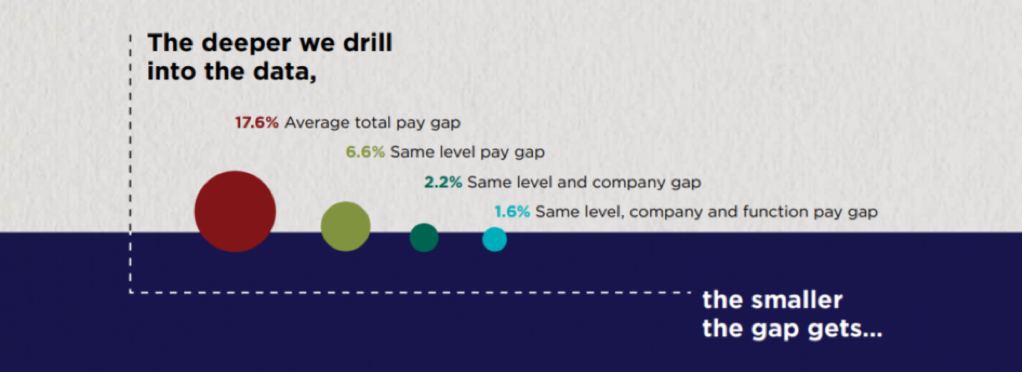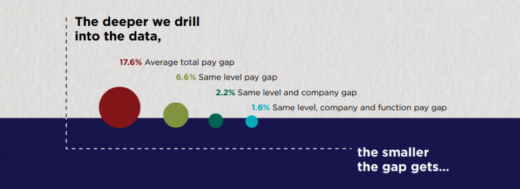Who is Addressing the Gender Pay Wage Gap?
— November 6, 2018
As a WBENC-certified, woman-owned business we got our start over twenty years ago because our founder was bumping into a glass ceiling her peers who were men were not. We would not call it a wage gap specifically but more of an opportunity gap.
For us, this still impacts how we run our marketing executive search firm today. For all our searches we include female and diverse candidates in our short list. Regardless of the time and effort this requires. If we always present a diverse slate of candidates over time, our clients will have a more diverse leadership team while always having the opportunity to choose top talent.
Our place in the process gives us a unique perspective on the gender wage gap. Does it exist and if so, how big of a problem is it?
If you look at the research, you will find very different answers. According to Pew Research Center, “the gender gap in pay has narrowed since 1980, but it has remained relatively stable over the past 15 years or so.”
In 2017, women employees made only 80.5 cents for every dollar earned by men – a pay gap of 20 percent according to the Institute for Women’s Policy Research (IWPR).
However, when evaluating the earnings for women and men at the same company, at the same level, in the same function, the gap significantly decreases, according to Korn Ferry. The wage gap is “predominately caused by fewer women than men in higher-paying roles.” According to the Korn Ferry Gender Pay Index, “when considering the same level at the same company, the gap further reduced to 1.6 percent.”

Source: Korn Ferry
Payscale reports similar findings. According to their “The State of the Gender Pay Gap in 2018” report, a woman “earns 97.8 cents for every dollar earned by the man” when evaluating the earnings for equally qualified men and women in the same job.
We do not believe women experience a 20% pay gap in Corporate America, if women truly worked for 20% less than a man, men would have a tough time finding a job. When looking at causes for the overall wage gap, women are more likely to go into lower paying jobs like teaching and nursing than men are.
One of the reasons for the gap is women face more career disruptions and have less career flexibility than men, typically around choosing to leave a job to care for their family or have kids, and once they return, how do you price them back into the job market?
Overall, a wage gap somewhere between one and a half and seven percent does exist today. While this is a big improvement and the gap continues to narrow, we still have work to do.
A Marketing Executive Search Firm’s Take on the Gender Wage Gap
This pay gap, regardless of how minor or not it is, still exists; and while in general the gap is small, we tend to find examples where it can be significant. When we do find someone who is priced well under market rate for their skills, it could be a man or a woman but is more likely to be a female.
Overall, companies want to do the right thing, the challenge with doing the right thing is balancing conflicting priorities. In the long run, taking the high road will benefit everyone.
Salary inequity affects employees’ job satisfaction, causing disengagement and lower productivity. This ultimately leads to a loss in revenue and profit, impacting your bottom-line. According to Korn Ferry, “companies in the top quartile for gender diversity are 15% more likely to have financial returns above the median for their respective national industry. In fact, going from 0% to 30% women in corporate leadership is associated with a 15% increase in profitability. Greater gender diversity is also associated with more innovative work cultures, the ability to better connect with customers and a better-perceived brand image.” Unfair pay also drives top talent out of your organization in search of better opportunities.
So, how can pay equality be achieved? Is there anything being done to close the gap?
Much of the recent media and political focus on this issue has brought attention on this matter, and we’re seeing certain efforts made by the government to combat it. There’s a significant role here for HR departments to play. HR stands at the core of addressing the issue and has the power to make changes to help the progression of equal pay move forward.
Starting with a Great Relationship
As a marketing recruitment agency, we do our best to ensure our candidates will be compensated fairly and be excited on their first day of work; conversely, we work to make sure our clients will receive a strong return on their talent investments. It is an important balance for us to navigate.
Occasionally, we recruit a top performer who is not being paid like one. Fortunately for us and our client, this makes them motivated to make a change and you want to show them they will not have the same challenge with your company.
The first step for HR is to compare them to the peers you have in your organization to see an appropriate level of pay. It is only fair if they will be doing the same work, they should receive the same pay, even if this means you are the one providing them with a large bump to bring them to a fair market rate.
Once this employee sees how they are being treated in the beginning, doing the right thing pays for itself with loyalty and dedication.
Do the Right Thing (Even If It’s an Unpopular Decision)
We understand that keeping salaries within the budget is necessary. However, the best employers and workplaces strive to do the right thing in all areas of the business. This involves increasing the salary of new hires to get them to a fair pay level if necessary.
HR has an opportunity to work to create a culture that bases salary on qualifications and experience – not on previous earnings. Working off previous salaries can underline and perpetuate any existing inequalities.
Providing your employees to get the compensation they deserve is the highest and best thing to do by the candidate and your corporation, even if it’s deemed an unpopular decision by others inside the organization. Too often, leaders choose plans and solutions that are in the middle. If someone is under market we will move them towards market rate but not take them fully the where they should be. This easy and less risky solution is rarely the best decisions for everyone involved in the long run.
By understanding HR best practices, adopting a forward-thinking mindset, you have the opportunity to bring employees who are underpaid to market rate, compensate them for what they deserve and to initiate change for equality. While bringing in a talented, loyal and driven new employee.
The Power Lies in the Hands of HR
HR departments do a great job of acquiring and helping retain talent, building a sustainable culture, and taking the organization forward from a talent perspective. They play a tremendously critical and valuable role in the business and have the power to initiate great change for fair pay.
The HR department is the thought leader when it comes to best practices around employment, compensation, and building a sustainable culture. Your perspective on talent is critical to the success of an organization, and you have a great opportunity to be an advocate for new employees, so take a minute to take a deeper look at compensation and make sure you are not unintentionally continuing the wage gap with a new employee. This may lead to some potentially difficult conversations, but being the advocate for equality is ultimately in the best interest of the organization and the right thing to do.
It’s important for leaders and HR to empower women to strive for top-level positions with confidence. By encouraging women to pursue more leadership roles, you will see how this type of culture strengthens your organization overall.
According to Korn Ferry’s Global Leader for CEO Succession, Jane Edison Stevenson, “pay parity is still a very real issue, but it’s an issue that can be addressed if there is an ongoing effort to enable, encourage and select talented women to take on and thrive in challenging roles. Our research shows women have the skills and competencies needed to ascend to the highest levels within organizations, and it should be a business imperative for companies to help them get there.”
As HR, you have the influence and leadership in your business to become the champion for pay equity. Be the voice inside the organization and take charge eliminating any wage gaps.
Conclusion
As an experienced marketing executive search firm, we know how important it is to have a diverse slate of candidates and make compensation a win-win for both sides. If you find someone who is under market take the time to understand why and if you see someone who is paid less based on their gender you have an opportunity to make it right before they start and build loyalty that will last.
From marketing recruitment agencies, to executive leaders, to HR, we all play a role in bringing in talent that moves the company forward in a way that says something important about who you are as an organization and what you stand for as a culture.
When it comes to speeding up the progress of closing the wage gap, the responsibility ultimately will fall on HR. HR has the power to eliminate pay gaps in each company, eventually leading to a larger impact on the entire workforce. By stepping up and being the champion for equal pay, you move your business forward.
Business & Finance Articles on Business 2 Community
(23)


